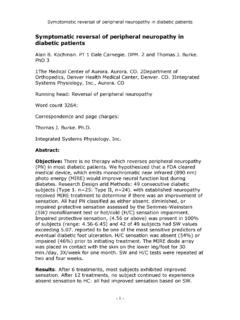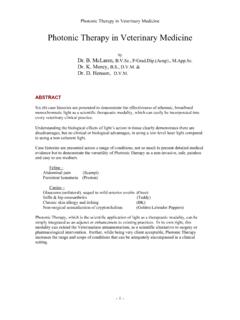Transcription of 26.10 News Feat Power games NEW MH
1 Seventy-five years ago, Otto warburg s star was at its zenith. The pioneer-ing German biochemist delivered his Nobel address in December 1931. He described the ingenious experiments by which he had unmasked the enzyme responsible for the critical step of cell respiration, the process that turns the energy in chemical compounds into energy the cell can use. His work on res-piration in the early 1930s nearly earned him a second Nobel, ultimately denied him by Hitler. Then his star began sinking. His ideas on the importance of cell respiration in cancer led many to dismiss him as a crank. And the rise of molecular genetics in the 1960s put such ideas into a far distant now, warburg s star is rising again.
2 A new generation of researchers is returning to his ideas about respiration in cancer cells. Recent findings suggest that the enzyme he identified, cytochrome oxidase, is a key player in a new understanding of how the cell s energy metabo-lism affects health and disease. And surpris-ingly they show that light has a profound effect on how the enzyme works and could even be used to treat degenerative extract energy from molecules, the cell first breaks down glucose into simpler mole-cules via a process called glycolysis. It then feeds these molecules into energy-producing struc-tures called mitochondria, which strip electrons from them to produce energy with the help of oxygen. As warburg showed, cytochrome oxi-dase governs the last reaction in this the most surprising aspect of the renaissance of warburg s ideas is that the methods he used to make this discovery matter again.
3 They exploit two chemi-cal quirks: carbon monoxide (CO) can block respiration by binding to cytochrome oxidase in place of oxygen; and a flash of light can displace it, freeing up the site for oxygen to bind again. Self controlBy measuring oxygen consumption at different wavelengths of light, warburg worked out that the enzyme belonged to a group of proteins that include haemoglobin and chlorophyll. But for warburg , the binding of CO to the enzyme was just an oddity he could put to good use. He had no inkling that biology might use the same trick. Yet over the past decade, researchers have come to appreciate that cells often use CO, and to an even greater extent NO (nitric oxide), to block respiration.
4 Not only that, but light has striking counter-effects on cytochrome oxi-dase. And all these suitors to the enzyme turn out to be critical to our understanding not just of cancer, but practically all degenerative oxide is emitted by nerve endings and can act on an enzyme called guanylate cyclase to relax blood vessels the impotence drug Viagra manipulates this system. For a long time, scientists thought that guanylate cyclase was NO s only target. But in the mid-1990s, they found that the molecule can also bind to cytochrome oxidase and hinder respiration1. What s more, it could do so at levels found in the body s finding that the body could poison one of its own enzymes was initially shrugged off as an imperfection an example of how evolution cobbles organisms together with no forethought.
5 But a few years later, several groups reported that mitochondria harboured Power GAMEST here s a fight going on inside all our cells for each breath of air. Nick Lane sheds therapeutic light on the implications for cancer and degenerative diseases. The finding that the body could poison one of its own enzymes was initially shrugged off as an imperfection. S. GSCHMEISSNER/SPL901 NATURE|Vol 443|26 October 2006 NEWS FEATURE Nature PublishingGroup 2006an enzyme that synthesizes NO (ref. 2). Why would cells go out of their way to cook up NO right next to the respiratory enzymes?According to cell biologist Salvador Mon-cada of University College London, evolution really has crafted cytochrome oxidase to bind not only oxygen but also NO.
6 One effect of slowing respiration in some locations is to divert oxygen elsewhere in cells and tissues, he says. This prevents oxygen levels sinking dangerously low. Moncada, for example, has shown that NO blocks respiration in the cells lining blood vessels and that this helps to transfer oxy-gen into smooth muscle cells in these vessels. Fireflies use a similar trick to flash light (see Flashing the gauntlet ).But the consequences of blocking respiration go beyond diverting oxygen. Respiration, Moncada argues, is not just about generating energy, it s about generating feedback that allows a cell to monitor and respond to its environment. Blocking respiration generates chemical signals, in the form of highly reac-tive molecules called free radicals.
7 These are normally associated with cell damage, but now it seems they can interact with the proteins that control gene activity and adapt cells to chang-ing circumstances. Free radicals had a bad reputation, says pathologist Victor Darley-Usmar, of the University of Alabama, Birming-ham. But we now see them as signals. In the past few years, researchers have com-piled a list of these proteins, or transcription factors, the activity of which depends , at least in part, on interactions with free radicals3. These include many proteins known to be linked to cellular life and death, such as P53, a protein that kills cells if they show signs of turning can-cerous. The question is, says Darley-Usmar, how is the whole system controlled?
8 The answer lies in the tens of thousands of protein machines that line each mitochondrion. Organized into chains, they pass electrons extracted from broken-down glucose on to each other. The end-point of the chain is cyto-chrome oxidase, which catalyses the final step of respiration, in which electrons and protons are transferred onto oxygen to form water. Energy released by this process is used to pump pro-tons over a membrane, creating an electrical charge. The cell can then use this charge to Power an enzyme that makes ATP, a mol-ecule that fuels chemical reac-tions in the cell. The cell can suppress the number of free radicals coming from these respiratory chains by allowing protons to leak back though the membrane without driving the synthesis of ATP, a process known as radicalsBut if uncoupling doesn t bring free-radical leak under control, the signal may be amplified.
9 There s a cross-talk, known as the retrograde response, between the mitochondria and genes in the nucleus, which we re only just beginning to explore, says cell biologist Keshav Singh of the Roswell Park Cancer Institute in Buffalo, New York, who helped uncover this mecha-nism. If we can modulate this signalling, we might be able to influence the life or death of cells in many pathologies, even ageing. In cancer cells, something goes awry with this pathway. Free radicals can trigger two steps in carcinogenesis, chromosomal instability and metastasis5, by hindering DNA repair and pro-moting the activity of genes involved in cancer spread. We ve found that damaged mitochon-dria, which overproduce free radicals, under- If we can modulate this signalling, we might be able to influence the life or death of cells in many pathologies.
10 Keshav SinghGas station: by binding to the cytochrome oxidase enzyme (left), NO regulates flashes have lit up the human imagination since antiquity. Light is produced by the action of the luciferase enzyme, which uses ATP to activate luciferin to a luciferyl adenylate intermediate. This in turn reacts spontaneously with oxygen to emit a photon, giving rise to sequence of flashes, which often beam complex messages to potential mates, clearly requires exquisite nervous control. But no nerve cells connect directly to the lantern cells that produce the light, suggesting that some kind of intermediary is needed to ferry messages from the nerve endings. Barry Trimmer and his colleagues at Tufts University in Medford, Massachusetts, have shown that this is likely to be NO (ref.)





